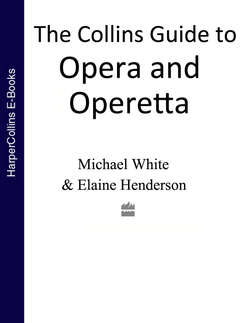Читать книгу The Collins Guide To Opera And Operetta - Michael White - Страница 62
ОглавлениеLakmé
FORM: Opera in three acts; in French
COMPOSER: Léo Delibes (1836–91)
LIBRETTO: Edmond Gondinet and Philippe Gille; after Loti’s novel
FIRST PERFORMANCE: Paris, 14 April 1883
Principal Characters
Lakmé Soprano
Mallika, her slave Mezzo-soprano
Hadji, her servant Tenor
Nilakantha, Lakmé’s father, a Brahmin priest Bass-baritone
Gérald, a British officer Tenor
Frédéric, a British officer Baritone
Synopsis of the Plot
Setting: Imperial India; 19th century
ACT I Gérald, his fiancée and other friends, are wandering near Nilakantha’s home when they come across the temple, breaking down a bamboo fence to gain access. Gérald is left behind, sketching, as the others move on and is seen by Lakmé and Mallika. Gérald is instantly entranced by the beautiful Lakmé, who responds to his fervour, although her main concern is his safety; her father harbours an implacable hatred for the British occupiers of India. Gérald disappears through the broken fence as they hear Nilakantha returning. Nilakantha notices the damage and swears vengeance on those who had dared to profane his sacred ground.
ACT II While visiting the market Gérald hears Lakmé singing – a trap devised by her father to catch the man who desecrated his garden, attracted there, he believes, by Lakmé’s beauty. When Lakmé sees Gérald she faints and he rushes to her side. Nilakantha stabs him.
ACT III Helped by Hadji, Lakmé has taken Gérald to a secret hideaway. But Frédéric has followed the wounded officer and, when Lakmé goes to fetch water from the sacred spring, he appeals to Gérald to leave with the regiment that night. Gérald agrees. When she returns, bringing the water that, when drunk by lovers, assures them of everlasting love, Lakmé senses his change of heart. She takes a leaf from the poisonous datura tree and bites it, before they drink the water together. Gérald is broken-hearted when she dies, but her father, knowing that his beloved daughter will have eternal life, accepts her death with equanimity.
Music and Background
While Lakmé’s plot has the sort of exotic setting fashionable at that time, the music is uncommonly well-written and fresh-sounding for a score that doesn’t attempt anything particularly radical. The models are Massenet and Bizet, and its decorous melodies sing out in strictly formal, self-contained numbers as though Wagner had never existed. But no matter. With appealingly restrained touches of oriental colour and enchanting lyricism it remains a winner with audiences and singers alike. Most of the great sopranos with a claim to coloratura – the ability to negotiate highly decorative vocal lines – have been drawn to the title role.
Highlights
The famous Act I ‘Flower Duet’ for Lakmé and Mallika is a celebration of the female voice, spinning embroidered skeins of song in long, unbroken, creamily seductive measures. Lakmé’s Act II ‘Bell Song’ is a showpiece aria.
Did You Know?
The famous ‘Flower Duet’ became still more famous when British Airways borrowed it as the theme to their long-running TV commercial. They use the less commendable EMI recording with Mady Mesplé.
Recommended Recording
Joan Sutherland, Alain Vanzo, Monte Carlo Opera/Richard Bonynge. Decca 425 485-2. Sutherland in glorious form, even if you don’t get the consonants.
